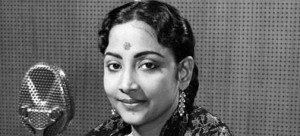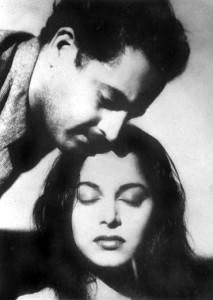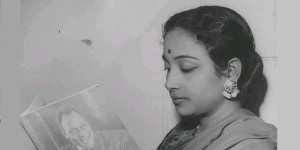Geeta Dutt Roy, an unlucky skylark
(23.11.30 – 20.7.72)
By K. Raman
In memory of her birthday exactly 83 years ago on November 23, Geeta Dutt ”“ the great singer whose songs are still in huge demand by Sydneysiders in concerts by local singers”¦
“Yaad karoge Yaad karoge, Ek din hamko yaad karoge”
That is exactly what we are doing here and now.
Geeta Dutt was a brilliant playback singer of Hindi films, strikingly beautiful with dreamy almond eyes, who left us nearly 39 years ago. Despite possessing a rich voice, her career was heavily marred by bad luck and an unhappy marriage.
Daughter of a wealthy Zamindar, Geeta Dutt was loaded with musical talents. Burman Da, Anil Biswas, Hemanth Kumar, Salil Choudhry and other great Bangali composers were ready to give her a helping hand even without her even asking such a favour. But in the end it did not fully materialize as desired. Her life was riddled with unhappiness, obstacles, tragedies and sadness which collapsed after a short life span of 41 odd years. The legacy she left behind by way of her brilliant and unique style of seductive singing, voice modulation brilliance and the unusual tonal quality is still admired by even those who were not even born when Geeta was in her prime.
Geeta Roy was born in a rich family in Faridapur district (East Bengal, currently in Bangladesh) in 1930. Not much is known about her earlier life as a young girl until she appeared as a sixteen year old singer in Bhagat Prahlad (1946). The man who spotted her singing talents was Hanuman Prasad who made her sing just two lines of melody in that film. From that frugal start her progress was meteoric via successful films like Do Bhai, Baazi etc, to start with.
There was a rare and unusual swing in her voice texture which attracted keen listeners. Dev Anand introduced Guru Dutt, an up and coming actor, to Geeta during one of his regular weekend parties. In the film Baazi, (starred by Dev Anand and Geeta Bali) Dev Anand employed Guru Dutt as the director of the film production, in which Geeta sang an immortal and emotional number, “Tadbeer se bigadi hui”. Guru Dutt instantly fell in love with her by hearing this song. Geeta had eight solos in this film which all turned out to be very popular and successful numbers.
The chasm between the two was a constant factor in their tumultuous eleven years of life together (1953-1964), though initially they fell for each other head over heels. Guru Dutt was a Konkani Saraswat Brahmin (named initially as Vasantha Kumar Shivasankar Pudukone) a man with a brilliant mind in film matters, and one who was far ahead of his time.
Geeta and Guru got married in 1953, though both the households had reservations of this union. Always moody, with tendencies of emotional blunting and mood swings, he might have been be an undetected schizophrenic from a young age. Observers interpreted his quite aloofness to his brilliance and thinking disposition.
Guru Dutt produced some classic films around this time and the female voice for his films was always Geeta Dutt. All her songs were massive hits. They had a happy married life initially and three children were born in quick succession (Tarun, Arun and Nina).
While Guru Dutt was filming C.I.D, his new find, a beautiful and highly talented actress from Chengalpet (Tamilnadu) became the villain of the happy and sacred married life of Guru and Geeta. Guru Dutt was infatuated with Waheeda, (who will not be if you had seen her in real life then or in the role of Kamini, the seductress in C.I.D) and he virtually left Geeta and children in the lurch.
Geeta Dutt had a nervous breakdown and it was so bad she could not even recognize her children, and she took solace from alcohol. Her majestic voice and regal image were ravaged by alcohol. She was not keeping up her singing appointments and this was happening at a time when young Lata was fast climbing up the success ladder. Geeta never recovered from the evil clutches of alcohol. More tragedy was in store. Guru Dutt committed suicide (alcohol plus sleeping pills) on 10 October, 1964.
Everyone knew that Guru Dutt was too ambitious. Ambition is a type of passion that can be destructive too; it is a double edged sword. In Guru Dutt’s case it drove him to the point of no return. This was a shock that virtually broke Geeta.
She sang:
“Mera sundar sapna beet gaya,
Mere prem mein sub kuch haar gaye-
Bedard zamaan jeeth gaya”
(This song sung by her was a true reflection of her real life then.) Her eldest son commited suicide at a young age and to Geeta it was part of a parade of misery. Cirrhosis of liver took her away on 20 July, 1972, at just over 41 years age.
Geeta had a unique voice with exceptional mellifluous tonal purity with unusual swing and it fuelled pathos and other emotions in the mind of the listeners. The fluidity of her rendition with her God-given originality made her a unique singer of class. Be it a bhajan or a Western cabaret pictured on Helen, she was equally at ease. It was often mentioned in film magazines in early fifties that the new comer Lata was initially scared of Geeta’s ability to sing and the high esteem with which music directors regarded her. She thought it was a big stumbling block for her onward march.
S.D. Burman and O.P. Nayyar brought out Geeta’s inherent voice culture and singing ability to the fore. The great talent spotter S.D. Burman knew about the singing ability of Geeta and he guided her to sing jazzy songs in the crime movie Baaz for which he scored music. O.P. Nayyar took the lead and made her a great singer of his new style of swingers. When she got addicted to alcohol she was not attending music recordings on some silly excuses and that opened opportunities to Asha Bhosle while the doors were shut on Geeta Dutt. To avoid a total wipe out Geeta took part in stage shows and even ventured to be a producer of films, with no success. Film music world is a vicious cut throat field in which even the greatest of singers who disregarded the wishes of top music directors, will never get a footing inside the recording studios for the second time.
The children were very close to their mother because of the way Guru Dutt treated the family, especially their mother. She was a kind hearted house wife with malice towards none and charity for all. Even when it became clear that Guru Dutt left Geeta for a younger and stunningly beautiful Waheeda Rehman, Geeta did not harbour ill feelings to Waheeda but blamed her husband whom she loved and regarded well.
Even though Guru Dutt negotiated with Waheeda’s parents to marry her, they were not supportive of that move. Religion became the major stumbling block. I feel that he had some acute mental sickness as he attempted suicide on two previous occasions, both of them failed somehow or other.
Two of their children are now middle aged. They said recently that a producer of successful films, Guru Dutt, spent many lakhs of rupees for lavish productions like ”˜Kagaz ke phool’ and did not leave a Rupee to his loving wife in the end. She lived in poverty and this saddened their helpless children very much. They said, “we hardly ever saw him all through the time he lived”.
Guru Dutt’s mother was openly canvassing him and others who had influence on him to get him married to Waheeda Rahman. Guru’s mum did not like Geeta Dutt at all and it was an open secret then. On his death a set of people alleged it was not a case of suicide but a well-planned murder. On the day he died he had talked to Mala Sinha who was the heroine of the film he was shooting then, about the scenes to shoot on the next day. It is quite obvious that a man who planned to commit suicide will not be planning the filming schedule and shoot to take place on the next day or so.
I began compiling a mini list of Geeta Dutt’s hits, but found it very hard to do so because each one of her hit songs had individual class and uniqueness and it was difficult to pick the favourites. However, I give below my final short listing:
1. Thandi hava kalighata (Mr & Mrs 55); 2. Yeeh hai Bombay meri Jaan (C.I.D); 3. Babuji Dheere chalna (Aaar paar); 4. Mera nam chin chin chu (Howrah bridge); 5. Tadbeer se bigadi hui (Baaz); 6. Ankhon hi ankhon mein (C.I.D); 7. Udhar tum haseen ho (Mr & Mrs 55); 8.Waqt ne kiya (Kagaz ke phool); 9. Zun zun zun salima (Aar paar); 10. Jane kya tune kahin (Pyasa). 11. Ae dil muje batha do (Bhai Bhai); 12. Yeh to mein haari piya (Aar paar), my all-time favourite; 13. Ja Ja Ja bewafa (Aar Paar).
Before his death Guru was seriously contemplating to reconcile with his wife to forget the bad past and go back to a happy life. But it was not to be so.
I met Geeta Dutt on four separate occasions, thrice in her modest house and once in a studio recording session. Of these one was while she was on top of the singing world, a happy and pleasant well-mannered house wife. The other two were while she was going down the slippery dip. I remember her tidy house with things in place and a portrait of Guru Dutt, garlanded with incense sticks burning.
She had good taste in clothes and the jewellery she wore. She had a limpid look with a smooth carriage. She was cultured, comely, well read and articulate, unlike the other singing mob we are familiar with. So good looking she was, that she could walk into any film set as its leading lady. To any onlooker she presented as if she was the celestial nymph just raised from the swirly waters of a holy river. She, more than once, talked in detail of her attachment to her family and her life as a film singer. Never once she had a bad comment about any of her co singers or music directors. She only had good things to say about them. In my last meeting, I saw melancholy etched all over her beautiful expressive eyes. I still see her infectious smile, a feature of her persona that cannot be wiped out from my memory. Fate was cruel to a nice person who lived an eventful 41 years.
Short URL: https://indiandownunder.com.au/?p=2782





